
A few months ago, RP Singh wrote a very timely post on compassion and what it means to Sikhs. In Gurbani, the word Daya often translates to compassion, a trait which is long known in our history. One of the Panj Pyara or beloved five was Bhai Daya Singh and thus, Compassion along with Justice, Courage, Discipline and Leadership are important elements of the Khalsa.
As a reminder of this and as we get ready to begin a New Year – I wanted to share with you the Charter for Compassion – “a call to bring the world together.” It is stated that, The principle of compassion lies at the heart of all religious, ethical and spiritual traditions, calling us always to treat all others as we wish to be treated ourselves. Compassion impels us to work tirelessly to alleviate the suffering of our fellow creatures, to dethrone ourselves from the centre of our world and put another there, and to honour the inviolable sanctity of every single human being, treating everybody, without exception, with absolute justice, equity and respect. [link]
I would encourage you to watch the video below and sign the charter. It might be a passive form of activism, however, let it be a nudge to hold ourselves accountable in the coming years – to live compassionately and emulate Sikhi in one of it’s purest forms.
Healthcare reform, immigration reform, banking reform, and the list goes on. This past week a diverse coalition lead by Rep. Luis Gutierrez (D-Ill) are laying down the marker in 2009 for comprehensive immigration reform by introducing the Comprehensive Immigration Reform for America’s Security and Prosperity (CIR-ASAP) Act of 2009. This bill has not been passed yet; it has only been introduced.
In a country built on the hard work of immigrants, it is imperative that this group be protected in the United States. Recently, there was a report that 1/3 of Los Angeles’s economy is dependent on immigrants. Also, immigrants are known for their entrepreneurship in small businesses. Tuyet Le, Executive Director of the Asian American Institute, says: “Family-based immigration has long created the foundation for strong, entrepreneurial communities across the country. This bill will reunite immigrants with their loved ones and will also provide some increases in high-skill temporary worker visas.”
This legislation focuses on undocumented students, family reunification, and worker visas-issues affecting our Punjabi Sikh community in America. For example, CIR-ASAP would allow undocumented high school graduates who came to the United States before the age of 16 to attain legal residency. This residency would open up educational and financial aid opportunities. This portion of the bill is modeled after the DREAM Act of 2009, except that it shortens the six-year wait period to three years and removes fines.
Yesterday was International Human Rights Day where people across the globe were asked to recognize and take action against the many forms of human rights abuses that take place in the world. A powerful talk on TED by Sunitha Krishnan brought insight into the grueling ground realities of sex trafficking in India- a human rights abuse that affects millions of women, their children and families. Krishnan addresses both what it looks like and the difficulties of rescuing women and their children from this $10 million industry. Krishnan says, “It’s normal to be raped by 100 men a day and abnormal to live in a shelter. It’s abnormal to get rehabilitated. It’s in that context that I rescue children. I rescue children as young as 3 years and women as old as 40 years.” Krishnan has rescued 3,200 girls.
She highlights how this modern day slavery and third largest form of organized crime affects those of all backgrounds-from middle class IS officers’ daughters to street children. You can watch the talk here (disclaimer: the talk contains graphic images and descriptions of violence).
Her work on commercial sexual exploitation is powerful because of her courageous attitude towards rescuing victims. Krishnan’s tenacious spirit coupled with her collaborative approach of bringing government, NGOs, and corporations together to fight sexual trafficking is unique. While listening to her talk, I found her organization’s approach to moving women in the commercial sex trade industry into new jobs particularly unique. An essential part of these women’s rehabilitation is to gain a new economic skill set that utilizes the power from their pain while harnessing their potential. Thus, girls are being trained as professional welders, carpenters, and mansons instead of working on computers. Often providing technical skill sets in information technology is seen as powerful form of empowerment, particularly in a place like Hyderabad-the technological capital of the world. So, “why welding and not computers?” Krishan says,
“They had an immense amount of courage without any “pardahs” inside of their bodies. They could fight in a male dominated world very easily and not feel shy about it. [By working] as carpenters and masons … as security guards and cab drivers … they are gaining confidence, restoring dignity, and building hope. “
These women excel in their careers and works for large corporations. However, the biggest obstacle they continue to face is not economics but the lack of empathy from civil society. The stigma that these women live with even after moving out of the sexual trade industry forces them to suffer in silence. Krishnan says that civil society has “Ph.D.s on victimizing a victim”. She requests that within our limited worlds, civil society needs to open their minds and hearts to accept these victims of sexual trafficking as human beings. It is an essential part of their rehabilitation as is gaining an economic skill set.
Blogged by: Amol Singh
 In events and programs highlighted at remembering 25 years since 1984, the most vocal criticisms of these remembrances revolve around a desire to forgive or forget. For many it seems regressive and contradictory to highlight these tragedies while India hoists its Sikh Prime Minister to the world’s stage. On November 18, Amnesty International released a public letter to President Barack Obama, to mark Manmohan Singh’s impending visit to Washington, in which they highlighted grievances of not only Sikhs against the Indian Center, but also those of Muslims, the victims of the Union Carbide tragedy in Bhopal, the entire Northeast, Kashmir, Dalits, Adivasis, Chattisgarh, Manipur, etc.
In events and programs highlighted at remembering 25 years since 1984, the most vocal criticisms of these remembrances revolve around a desire to forgive or forget. For many it seems regressive and contradictory to highlight these tragedies while India hoists its Sikh Prime Minister to the world’s stage. On November 18, Amnesty International released a public letter to President Barack Obama, to mark Manmohan Singh’s impending visit to Washington, in which they highlighted grievances of not only Sikhs against the Indian Center, but also those of Muslims, the victims of the Union Carbide tragedy in Bhopal, the entire Northeast, Kashmir, Dalits, Adivasis, Chattisgarh, Manipur, etc.
Even though India is the world’s largest democracy, serious and disturbing human rights abuses are ongoing, including rape, extrajudicial executions, deaths in police and military custody, torture, cruel, inhuman, and degrading treatment, arbitrary arrests, and dowry deaths. The Government of India not only fails to prevent these abuses, but also shelters members of security forces from facing justice. People living in several of the northeastern states of India and in Kashmir, religious minorities, those belonging to the lowest social order called “Dalits”, and indigenous communities called “adivasis” face the brunt of these abuses. Other socially and economically marginalized groups including women face discrimination at the hands of the police and criminal justice system. Although laws were passed to address some of these human rights abuses, serious concerns remain about the implementation of such laws.
Some of the specific contexts in which mass abuses were or continue to be committed include:
Mass killings of Sikhs: Over three thousand Sikhs were massacred when the governing Congress Party incited mob violence targeting Sikh civilians in reaction to the 1984 assassination of Prime Minister Indira Gandhi by her Sikh bodyguards. Scores of women were gang raped and some were burnt alive. After two decades, a judicial commission concluded that members of the governing Congress Party were involved. Twenty five years have passed since the massacre, but only a few have been brought to justice for this mass killing. [Read Full Text]
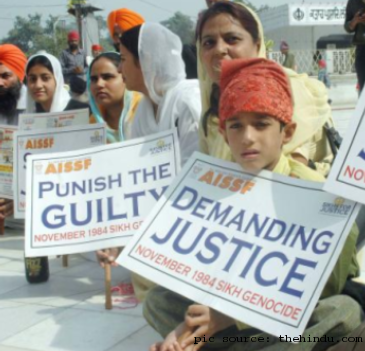 On Tuesday (November 3rd, 2009), various Panthic groups (‘radical’ Sikh organizations, if you follow Indian newspapers) called for a peaceful shutdown of stores, businesses, and state services to protest the continued impunity in which the perpetrators of the Indian Government-orchestrated pogroms in 1984 still roam free today.
On Tuesday (November 3rd, 2009), various Panthic groups (‘radical’ Sikh organizations, if you follow Indian newspapers) called for a peaceful shutdown of stores, businesses, and state services to protest the continued impunity in which the perpetrators of the Indian Government-orchestrated pogroms in 1984 still roam free today.
The ‘bandh’ was an overwhelming success in terms of its immediate call to action, although the larger purpose of its calling will probably continue to yield little results.
The strike call was given by the Dal Khalsa and was supported by the Khalsa Action Committee (KAC), Damdami Taksal, Delhi Sikh Gurdwara Prabandhak Committee (DSGPC), All India Sikh Students Federation (AISSF) and Shiromani Panthic Council.
25 years ago history was made for several different reasons. Today, as we reflect on the invasion, on the assassination, and on the massacres, we come across multiple news articles which provide information and commentary on the events of that year. I wanted to take the time to document and highlight these articles as they’re worthy reads in providing information to readers around the world. I encourage you to read these pieces – they are vital to our understanding and they will inform Sikhs and non-Sikhs alike about events in our history.
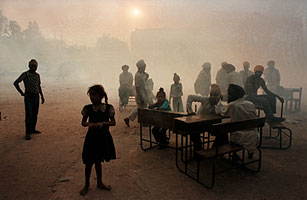 1. TIME magazine featured an article titled, “India’s 1984 Anti-Sikh Riots: Waiting for Justice.” Our readers have previously argued against the use of the word “riot” and suggested that “genocide” is the more fitting description of what happened. Regardless, this is an important article which discusses the often silent victims of 1984 – the widows and their children and the impact the events (and lack of justice) has had on their future.
1. TIME magazine featured an article titled, “India’s 1984 Anti-Sikh Riots: Waiting for Justice.” Our readers have previously argued against the use of the word “riot” and suggested that “genocide” is the more fitting description of what happened. Regardless, this is an important article which discusses the often silent victims of 1984 – the widows and their children and the impact the events (and lack of justice) has had on their future.
The widows’ colony in Tilak Vihar is a cheaply built and neglected cluster of homes, which were given by the government to hundreds of women and their children who survived what have become known as the anti-Sikh riots of 1984. But as the grim event’s 25th anniversary nears at the end of this month, crime, addiction and prostitution have taken root in what was supposed to be a survivors’ safe haven. Residents say this is because of the damage to the mental health of children who were witness to their parents’ and siblings’ murders and who grew up in impoverished homes and weren’t given any medical help — physical or mental — for their problems. [link]
Of note: for the 25th anniversary of the event, advertisements by Ensaaf — showing an old woman wiping away her tears, with the words, “25 years ago, our loved ones were burned alive in front of our eyes,” and in the next line, “Why has India, the world’s largest democracy, denied us justice?” — are scheduled for the month of November in the San Francisco Bay Area’s transit system!
Domestic violence organizations often use helplines to reach a larger population, while providing an anonymous format to offer help. The Punjab Government implemented a community health helpline 20 days ago to assist in locating ultrasound and abortion centers in a similar endeavour to protect women’s human rights.
The Chandigarh Tribune reports that this helpline (number# 4005252) is part of a pilot project coordinated by the National Rural Health Mission and has already reported a successful intervention. An ultrasound/abortion center in Sirsa, Haryana is being investigated after an anonymous caller reported that a young woman of Mansa village had recently aborted a girl child. Through immediate action, officials found that name/location of the ultrasound and abortion center. Also, they found out that the young woman had been forced to have an abortion by her mother-in-law. Now both the center and mother-in-law are under police investigation. The young woman is not being investigated since she was forced into the abortion by her mother-in-law after already having a 7 month old daughter.
Anurag Aggarwal, mission director, National Rural Health Mission says,
“The hotline gives an opportunity to women to speak up in case they are being forced to get their female fetus aborted. If she is not able to say anything, her relatives or friends can inform us. The caller’s identity is not asked and the whole thing is anonymous.”
The helpline at 4005252 runs from 9am-6pm and gives residents an opportunity to air their grievances and make their suggestions on health services in the state. Through successful implementation, the helpline is a good tool for practical action on the female foeticide issue. I wonder if we could create a similar helpline in various Diaspora communities because the rates of female foeticide are also high outside of South Asia. What do you think?
Guest blogged by: Amol Singh
Harinder Singh Jinda and Sukhdev Singh Sukha were hanged to death in Pune Jail for the assassination of General Arun Vaidya, the architect of Operation Blue Star. In the wake of their impending hangings, Sukha and Jinda sent an open letter to the President of India in which they documented their justifications for Sikh militancy and demonstrated how their actions were placed inside a global sphere of justice and necessity.
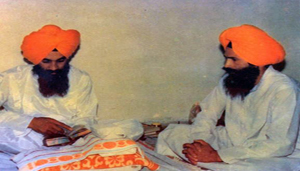 Sukha & Jinda’s letter contextualized Sikh militancy inside of a broader sphere of global defiance against outdated and arbitrary power structures.
Sukha & Jinda’s letter contextualized Sikh militancy inside of a broader sphere of global defiance against outdated and arbitrary power structures.
When nations wake up, even history begins to shiver. During such momentous moments a Banda Bahadur bids farewell to his peace-dwelling and destroys a State of oppression like Sirhind, a Che Guevera turns down a ministership of Cuba, loads a gun on his breast and entrenches against the enemies in the forest of Bolivia, a Nelson Mendela rejects the ideology of apartheid and prefers to spend his life in a dark prison cell.
Despite tanks rolling into the Guru’s Court (Darbar Sahib)
When a Singh’s head, becomes hunted as a sport (Delhi 1984)
Despite Kaljug sitting on his throne supreme
When the world trembles from tyranny’s regime
And Still We Will Fight
Although hardly a newsflash, last week a Delhi Court acquitted three murderers. Although low-level players in the Government-sponsored pogroms in Delhi and throughout India in November 1984, their acquittal further illustrates that it is Kaljug that reigns supreme in India.
Gurmeal Singh, the British Sikh police officer who was humiliated for practicing Sikhi, will be compensated for “indirect harassment” and humiliation. Judge Murray Creevy ruled that the Greater Manchester Police (GMP) viola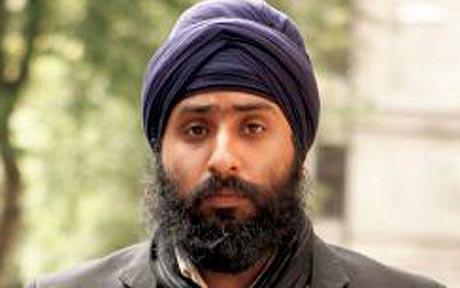 ted his dignity.
ted his dignity.
The BBC reports that the Assistant Chief Officer at GMP, Julia Rogers felt that they had always acted in the best interest of Singh. However, GMP accepts the ruling and has already updated their policies.
After a heated conversation with his Sergeant about his inability to remove his turban while on the job, Singh feared that he would be made to look like a comic character on television by wearing a modified turban.
Ultimately the ruling according to Singh’s lawyer:
“… leaves him in difficulty in relation to his future career but will hopefully open the eyes of Greater Manchester Police. He joined the police because of his values as a Sikh. What is important now is what Greater Manchester Police will do to help him come back.”
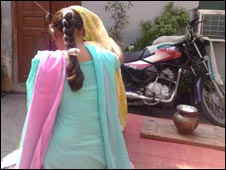 One of our goals on The Langar Hall is to raise awareness about issues affecting our community around the globe. Whether or not we identify or relate to these specific issues may not be as important as much as the acknowledgement that these issues do occur and that individuals and families and even children are affected. We hope that by raising awareness we can begin, as a community, to stand up against injustice in all its forms.
One of our goals on The Langar Hall is to raise awareness about issues affecting our community around the globe. Whether or not we identify or relate to these specific issues may not be as important as much as the acknowledgement that these issues do occur and that individuals and families and even children are affected. We hope that by raising awareness we can begin, as a community, to stand up against injustice in all its forms.
A recent article from the BBC reports that, according to campaigners in Punjab, British Asians are hiring contract killers to carry out up to 100 murders in India each year. One of the most well known cases is that of Surjit Athwal, a British Sikh woman who disappeared in Punjab in 1998. Eventually it was revealed that she had been murdered in a so-called honor killing after her in-laws discovered that she planned to divorce her husband. They had hired criminals in India to kill her. She was strangled and her body dumped in a river. Her brother, Jagdeesh Singh, now campaigns for other victims’ families.
“I think Surjit’s case exposed for the first time in this country overseas outsourced killings. How the Punjabi community, settled in Britain, send their females back to the land of origin, in the full knowledge that they can have them murdered easily, swiftly and efficiently.” [link]
So Abercrombie & Fitch is at it again or I should say has been at it for a  while-practicing bias against those who “don’t look the part” of mainstream White American society. In Tulsa, Oklahoma, a college age Muslim girl who wears a hijab is filing suit against the retail store for not hiring her because she would violate the “Look Policy”.
while-practicing bias against those who “don’t look the part” of mainstream White American society. In Tulsa, Oklahoma, a college age Muslim girl who wears a hijab is filing suit against the retail store for not hiring her because she would violate the “Look Policy”.
What is Abercrombie & Fitch’s “Look Policy”? The policy jargon aside, the bottom-line for this retail store is that hijab’s aren’t “sexy” because mainstream White America doesn’t view them that way and only sex sells.
Now of course Abercrombie & Fitch will not outright say that; though I am sure they will fight to preserve this “status quo” through legal, “objective” and “logical” means. It also seems like the very legal right that is supposed to protect religious freedom will be used to defend Abercrombie’s stance. Title VII of the Civil Rights Act of 1964 prohibits religious discrimination. The 197 amendment to Title VII defines religion to,
“… include all aspects of religious observance and practice, as well as belief, unless an employer demonstrates that he is unable to reasonably accommodate an employee’s or perspective employee’s religious observance or practice without undue hardship on the conduct of the employer’s business”.
 A couple of months ago the Sikh community was elated to see the Queen of England make two Sikh gentlemen her bodyguards. Thisact was seen as a huge step forward for Sikhs in the fight against discrimination for our religious articles of faith. It tremendously inspired many of us to continue the fight against Sikhs in the US Army and other places in the United States and Europe. It reflected what generations of hard Sikh work against discrimination for our religious articles of faith had done in the UK.
A couple of months ago the Sikh community was elated to see the Queen of England make two Sikh gentlemen her bodyguards. Thisact was seen as a huge step forward for Sikhs in the fight against discrimination for our religious articles of faith. It tremendously inspired many of us to continue the fight against Sikhs in the US Army and other places in the United States and Europe. It reflected what generations of hard Sikh work against discrimination for our religious articles of faith had done in the UK.
However, a recent case of a Sikh police officer in the UK feeling humiliated and offended for refusing to remove his turban as part of the Greater Manchester Police has shown us that as we take great steps forward we are still far away from taking a great leap against discrimination.
Gurmeal Singh, who is based in Wythenshawe Police station, near Manchester, said that he was coerced into walking into a petrol fire and told to wear a modified turban by colleagues. Despite telling police trainers that he had applied a flammable gel to his beard and refused to look like a character on a British comedy show, the officers told him- “this is what you signed up for”.
Singh said,
“My turban is not an article of clothing like a shirt or tie – it is part of me, a part of my religion and I feel as though my religion and I have become an issue for GMP.
“It has made me feel alienated. I was deeply offended and humiliated.”
The British Sikh Police Association are supporting Singh in his legal action. The hearing in his case continues.
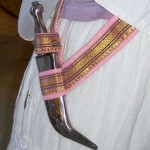 The California legislator has unanimously passed a Kirpan Education Bill (AB 504) through both houses (Assembly & Senate); it is now headed to Governor Schwarzenegger’s desk. This bill, carried by Assemblymember Warren Furutani (D-Long Beach) and other co-sponsors, will only become law if the California Governator signs off on it. AB 504 is a historic bill because it is the only piece of legislation in America that focuses on Sikhs and our kirpan. Furthermore, the bill is being pushed through the law-making process in California-a state with the oldest and largest number of Sikhs in America.
The California legislator has unanimously passed a Kirpan Education Bill (AB 504) through both houses (Assembly & Senate); it is now headed to Governor Schwarzenegger’s desk. This bill, carried by Assemblymember Warren Furutani (D-Long Beach) and other co-sponsors, will only become law if the California Governator signs off on it. AB 504 is a historic bill because it is the only piece of legislation in America that focuses on Sikhs and our kirpan. Furthermore, the bill is being pushed through the law-making process in California-a state with the oldest and largest number of Sikhs in America.
The Kirpan Education Bill (AB 504) requires that all California law enforcement officers be trained on Sikhs and our kirpan. This training would teach California law enforcement officers about Sikhs and the importance of our religiously mandated articles of faith. Sikhs wearing a kirpan are often disrespectfully approached by law enforcement officers and arrested for concealed weapons charges. Often law enforcement officers will pull Sikhs over for minor traffic violations or safety concerns and as soon as officers see the kirpan the situation is escalated into a criminal offense; although the Sikh was only practicing his/her faith. These officers are unaware that the kirpan is a religious mandated article of faith-a gift from our Guru that we wear with care, respect, and love.
Blogged by: Amritpan
 For many years UNICEF India has attempted to survey and document the declining sex ratio and female feticide in India. And for many years the government of India has maintained that Punjab (and thus Sikhs) consistently registered the highest number of ‘kuri maar’ cases, as compared to states such as Haryana, Himachal, Rajasthan, and Gujarat. So when a Punjabi doctor took the stage at United Nation’s Geneva Conference and dared to question the validity of the government’s survey methods, she was met with a ruthless legislative backlash so typical of Bharat’s political response to its human rights advocates that it almost doesn’t even prompt a second glance.
For many years UNICEF India has attempted to survey and document the declining sex ratio and female feticide in India. And for many years the government of India has maintained that Punjab (and thus Sikhs) consistently registered the highest number of ‘kuri maar’ cases, as compared to states such as Haryana, Himachal, Rajasthan, and Gujarat. So when a Punjabi doctor took the stage at United Nation’s Geneva Conference and dared to question the validity of the government’s survey methods, she was met with a ruthless legislative backlash so typical of Bharat’s political response to its human rights advocates that it almost doesn’t even prompt a second glance.
A renowned, outspoken crusader of women’s rights and a pediatrician at Rajindra Hospital, Patiala, Dr. Harshinder Kaur presented a paper to the Geneva Convention that explicated upon the abject conditions of women in India, disputed female feticide as being a Punjabi cultural phenomenon by asserting that Rajasthan has the highest number of feticides, and challenged India’s injudicious spending of the UN’s funds, urging that the UN redirect this monetary support to specialized NGOs.
Last week a Punjabi Sikh cab driver suffered a gruesome act of hate in the middle of the night in the Bay Area. He was called “Bin Laden”, a “terrorist”, and someone who had come to this country to kill Americans. His attackers where white males working professional jobs in real-estate. Not your stereotypical attackers, but committing a very typical act of hate. Although, the attackers posted bail with their money; the injured cab driver can not work to provide for his family.
We have laws to protect the attackers, but who is protecting the taxi-cab driver? How is it possible that assaulting a taxi cab driver is not a felony in every American city? Taxi cab drivers have one of the most dangerous jobs because of the environments in which they transport clients and how money for service is exchanged. They never know the character of the person they are picking up or if he/she will have enough money to pay. They function off the assumption that they won’t be attacked and their client will pay them. Otherwise, they could not make a profit in this business. They can’t let their fear overtake them.
At a recent conference, “Driving For The Future”, a taxi cab workers alliance in the Bay Area called United Taxi Cab Workers, announced that they are working towards a bill of rights. The Asian Law Caucus is working closely with this group. The bill of rights would demand, for example, that attackers suffer more severe penalties and there be a safety-net of benefits to help cab drivers who have been assaulted. In an industry employing large number of immigrant men who are not fluent in English; the need to legally protect taxi-cab drivers’ rights is very important. We need to encourage Punjabi Sikh taxi cab drivers to participate in this alliance to make sure their needs are protected.
In the Faridkot centre… Harmanbir Kaur, 15, was rocking gently backwards and forwards. When her test results came back, they showed she had 10 times the safe limit of uranium in her body. Her brother, Naunihal Singh, six, has double the safe level. [link]
An article in The Observer discusses the link between the dramatic rise in birth defects in Punjab and pollution from coal-fired power stations. Many of the children are being treated in Faridkot and at the Baba Farid centers for special children in Bathinda, where there are two coal-fired thermal plants. Staff at these clinics had noticed an increase in the incidence of severely handicapped children who were born with hydroencephaly, microencephaly, cerebral palsy, Down’s syndrome and other complications. They suspected environmental poisoning.
The healthcare workers rightfully voiced their concerns about this and wondered, if some children were being treated, how many more were being affected? As with governments’ other dirty little secrets, staff at the clinics were visited and threatened if they spoke out. In addition, a visiting South African toxicologist arranged for tests to be carried out and found that the children had massive levels of uranium in their bodies, in one case more than 60 times the maximum safe limit. The scientist was later warned by the authorities that she may not be allowed back into the country.
It used to be the case that women who came to the US as dependents on their husbands’ immigration status were  sometimes caught between a rock and a hard place. In cases where one spouse was abusive, the other spouse wouldn’t leave the relationship for fear of losing their immigration status and being sent back to their original country. If they returned to their original country empty handed and without their spouses, they would be perceived as failures. And so, many women have just endured extremely abusive relationships.
sometimes caught between a rock and a hard place. In cases where one spouse was abusive, the other spouse wouldn’t leave the relationship for fear of losing their immigration status and being sent back to their original country. If they returned to their original country empty handed and without their spouses, they would be perceived as failures. And so, many women have just endured extremely abusive relationships.
One option that has been available if the abuser is a permanent resident or a US citizen is a self-petition under the Violence Against Women Act. But this wasn’t available if the abuser was in the US on a temporary visa, as many immigrants initially are, or to women outside the US.
Thus, a recent development in asylum law has the potential to open a door to safety for at least some women who are most seriously abused in domestic violence. To qualify for asylum (or refugee status), one must have been a victim of persecution, or have a well founded fear of persecution based on their race, nationality, religion, political opinion, or “membership in a particular social group.” Before this summer, women who were victims of horrendous domestic violence were not recognized as a particular social group, though the issue has been argued for 14 years in a battle to allow battered women to seek asylum in the US. [link]
The government’s prior position under the Bush administration was illustrated in the case of R-A-, a woman who suffered horrific violence at the hands of her husband, a former soldier of the Guatemalan army. She was kicked, whipped, and beaten unconscious, nearly had an eye pushed out, was repeatedly raped, sodomized, threatened with machetes and guns, dragged by her hair, and had windows and mirrors broken on her head. [source 1, 2]. The Guatemalan police refused to help each time she went to them, deciding that hers was a domestic matter. RA fled Guatemala and her husband, seeking asylum in the US.
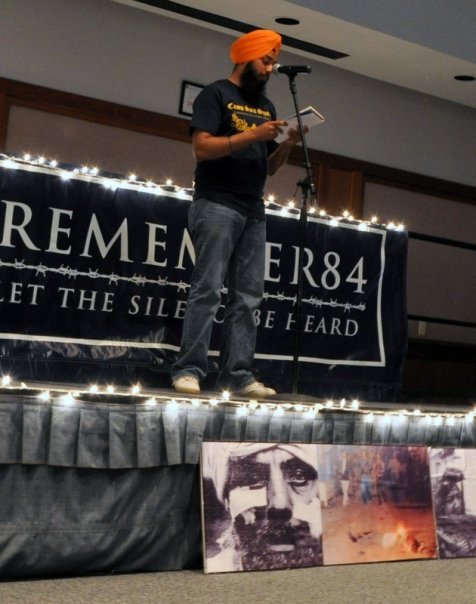 This past Saturday night, twenty artists from all over the country took to the mic in front of a packed and energetic crowd at the University of Maryland for Lahir 2009. It was a powerful evening of remembrance and reflection to commemorate the 25th anniversary of the 1984 Sikh Holocaust, organized by the DC Sikh Youth.
This past Saturday night, twenty artists from all over the country took to the mic in front of a packed and energetic crowd at the University of Maryland for Lahir 2009. It was a powerful evening of remembrance and reflection to commemorate the 25th anniversary of the 1984 Sikh Holocaust, organized by the DC Sikh Youth.
It was amazing to see teenagers, college students, young professionals, and even a few parents take to the stage and share their thoughts and reflections about 1984, human rights, and justice. Not only did the performers span across generations, but the performances themselves ranged in art form from musical pieces, poetry, and spoken word.
For me, it was fascinating to see how different each of the performers connected with 1984 – early in the show one artist eloquently recited an excerpt from Sirdar Kapur Singh’s 1966 speech to parliament, another tied environmental issues and water rights to 1984, while others shared personal accounts, poetry, dharmik geets, and dhadi vaaran. Regardless of how different each artist connected to 1984…the connection itself was strong…and watching that unfold on stage was absolutely breathtaking!
The evening concluded with G.N.E performing some of their recent tracks in front of their hometown audience. Seeing uncles and aunties “waving from side to side” was definitely a sight to remember.
 Gurdwara Panja Sahib, located just outside Pakistan’s North-West frontier province, has become the temporary home for about 3,000 Sikhs who have been displaced by the presence of the Taliban in the region. Gurdwara Panja Sahib is one of the most notable Sikh shrines in Pakistan and has been transformed into the ultimate role of a gurdwara. With help from community donations, the gurdwara has a clinic, a 24-hour kitchen and a temporary school for children. For the past two months, Sikh families have been living at the gurdwara, afraid to return back to their homes. Some of the region’s refugees have started to return back to their homes in military-protected convoys. However, many Sikhs feel they may never be able to move home,
Gurdwara Panja Sahib, located just outside Pakistan’s North-West frontier province, has become the temporary home for about 3,000 Sikhs who have been displaced by the presence of the Taliban in the region. Gurdwara Panja Sahib is one of the most notable Sikh shrines in Pakistan and has been transformed into the ultimate role of a gurdwara. With help from community donations, the gurdwara has a clinic, a 24-hour kitchen and a temporary school for children. For the past two months, Sikh families have been living at the gurdwara, afraid to return back to their homes. Some of the region’s refugees have started to return back to their homes in military-protected convoys. However, many Sikhs feel they may never be able to move home,
Two months ago, long-haired Taliban fighters stormed into Orakzai, a tribal agency near the Afghan border, brandishing AK-47 rifles and bringing a harsh demand: that the area’s 40 Sikh families should pay jazia, an ancient tax on non-Muslims living in an Islamic state. To encourage the payment of 12m rupees (£90,000), they kidnapped and tortured one of Singh’s neighbours. The Sikh community banded together to pay half the money, secured his release, then fled. “The Taliban are still demanding the money,” said Singh, a sprig of orange visible under his blue turban. “They recently rang me looking for the rest of the money. We are afraid they will find us, even here.” [link]

